CLICK HERE for information on taking the JLPT in the United States
The Japanese-Language Proficiency Test (JLPT) was developed in Japan, and has been offered since 1984 in countries all around the world as a means of evaluating the proficiency of non-native learners of Japanese.
In the beginning, there were approximately 7,000 examinees worldwide. By 2011, there were more than 600,000 examinees in more than 60 countries.
In the United States, more than 7,000 people registered for the JLPT in 2019. In normal years the test is administered at 18 test sites located around the country, on the first Sunday of December.
**Although a July test is given in Japan and a few other countries, the July test is NOT given in the United States.**
For American learners of Japanese, the JLPT offers a way to test your language skills and evidence of achievement that is comparable with other Japanese learners around the country and the world.
Click here for information on taking the JLPT in the United States
Read about one American’s experience taking the JLPT in Washington, DC, at http://blog.gaijinpot.com/taking-jlpt-overseas/.
The JLPT is offered in five levels (N1, N2, N3, N4, and N5, in order from most difficult to least difficult). N4 and N5 measure understanding of basic Japanese that is mainly learned in the classroom. N1 and N2 measure understanding of Japanese used in a broad range of actual everyday scenes.
Click here for a summary of the competencies required to perform well on each level
Sample Online Practice Tests: A guide to determining which level you should take. (The sample questions can be taken online, but please note that the actual test will be taken in person, on paper.)
The JLPT places importance not only on knowledge of Japanese-language vocabulary and grammar but also on the ability to use the knowledge in actual communication. In order to perform various “everyday tasks” that require language, not only language knowledge but also the ability to actually use it are necessary. Therefore, the JLPT measures comprehensive Japanese-language communicative competence through three elements: “Language Knowledge,” “Reading,” and “Listening.”
Click here for information on taking the JLPT in the United States
Please read our FAQ page.
If your questions are not answered, please email jlpt [at] aatj.org




